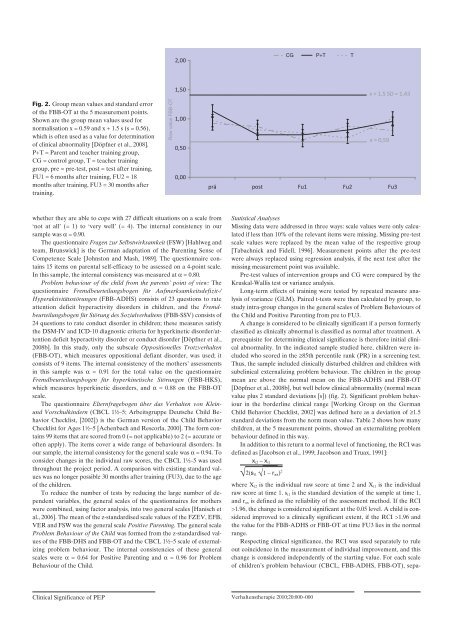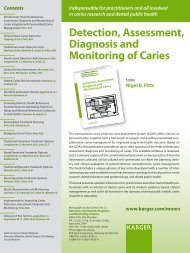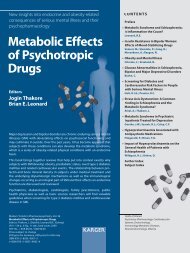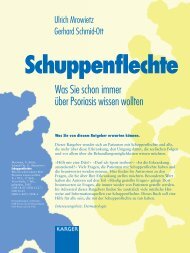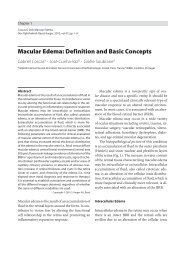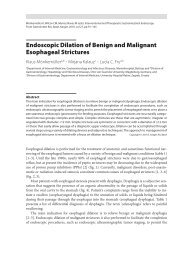Long-Term Clinical Significance of the Prevention ... - Karger
Long-Term Clinical Significance of the Prevention ... - Karger
Long-Term Clinical Significance of the Prevention ... - Karger
You also want an ePaper? Increase the reach of your titles
YUMPU automatically turns print PDFs into web optimized ePapers that Google loves.
Fig. 2. Group mean values and standard error<br />
<strong>of</strong> <strong>the</strong> FBB-OT at <strong>the</strong> 5 measurement points.<br />
Shown are <strong>the</strong> group mean values used for<br />
normalisation x = 0.59 and x + 1.5 s (s = 0.56),<br />
which is <strong>of</strong>ten used as a value for determination<br />
<strong>of</strong> clinical abnormality [Döpfner et al., 2008].<br />
P+T = Parent and teacher training group,<br />
CG = control group, T = teacher training<br />
group, pre = pre-test, post = test after training,<br />
FU1 = 6 months after training, FU2 = 18<br />
months after training, FU3 = 30 months after<br />
training.<br />
whe<strong>the</strong>r <strong>the</strong>y are able to cope with 27 difficult situations on a scale from<br />
‘not at all’ (= 1) to ‘very well’ (= 4). The internal consistency in our<br />
sample was a = 0.90.<br />
The questionnaire Fragen zur Selbstwirksamkeit (FSW) [Hahlweg and<br />
team, Brunswick] is <strong>the</strong> German adaptation <strong>of</strong> <strong>the</strong> Parenting Sense <strong>of</strong><br />
Competence Scale [Johnston and Mash, 1989]. The questionnaire contains<br />
15 items on parental self-efficacy to be assessed on a 4-point scale.<br />
In this sample, <strong>the</strong> internal consistency was measured at a = 0.80.<br />
Problem behaviour <strong>of</strong> <strong>the</strong> child from <strong>the</strong> parents’ point <strong>of</strong> view: The<br />
questionnaire Fremdbeurteilungsbogen für Aufmerksamkeitsdefizit-/<br />
Hyperaktivitätsstörungen (FBB-ADHS) consists <strong>of</strong> 23 questions to rate<br />
attention deficit hyperactivity disorders in children, and <strong>the</strong> Fremdbeurteilungsbogen<br />
für Störung des Sozialverhaltens (FBB-SSV) consists <strong>of</strong><br />
24 questions to rate conduct disorder in children; <strong>the</strong>se measures satisfy<br />
<strong>the</strong> DSM-IV and ICD-10 diagnostic criteria for hyperkinetic disorder/attention<br />
deficit hyperactivity disorder or conduct disorder [Döpfner et al.,<br />
2008b]. In this study, only <strong>the</strong> subscale Oppositionelles Trotzverhalten<br />
(FBB-OT), which measures oppositional defiant disorder, was used; it<br />
consists <strong>of</strong> 9 items. The internal consistency <strong>of</strong> <strong>the</strong> mo<strong>the</strong>rs’ assessments<br />
in this sample was a = 0.91 for <strong>the</strong> total value on <strong>the</strong> questionnaire<br />
Fremd beurteilungsbogen für hyperkinetische Störungen (FBB-HKS),<br />
which measures hyperkinetic disorders, and a = 0.88 on <strong>the</strong> FBB-OT<br />
scale.<br />
The questionnaire Elternfragebogen über das Verhalten von Klein-<br />
und Vorschulkindern (CBCL 1½–5; Arbeitsgruppe Deutsche Child Behavior<br />
Checklist, [2002]) is <strong>the</strong> German version <strong>of</strong> <strong>the</strong> Child Behavior<br />
Checklist for Ages 1½–5 [Achenbach and Rescorla, 2000]. The form contains<br />
99 items that are scored from 0 (= not applicable) to 2 (= accurate or<br />
<strong>of</strong>ten apply). The items cover a wide range <strong>of</strong> behavioural disorders. In<br />
our sample, <strong>the</strong> internal consistency for <strong>the</strong> general scale was a = 0.94. To<br />
consider changes in <strong>the</strong> individual raw scores, <strong>the</strong> CBCL 1½–5 was used<br />
throughout <strong>the</strong> project period. A comparison with existing standard values<br />
was no longer possible 30 months after training (FU3), due to <strong>the</strong> age<br />
<strong>of</strong> <strong>the</strong> children.<br />
To reduce <strong>the</strong> number <strong>of</strong> tests by reducing <strong>the</strong> large number <strong>of</strong> dependent<br />
variables, <strong>the</strong> general scales <strong>of</strong> <strong>the</strong> questionnaires for mo<strong>the</strong>rs<br />
were combined, using factor analysis, into two general scales [Hanisch et<br />
al., 2006]. The mean <strong>of</strong> <strong>the</strong> z-standardised scale values <strong>of</strong> <strong>the</strong> FZEV, EFB,<br />
VER and FSW was <strong>the</strong> general scale Positive Parenting. The general scale<br />
Problem Behaviour <strong>of</strong> <strong>the</strong> Child was formed from <strong>the</strong> z-standardised values<br />
<strong>of</strong> <strong>the</strong> FBB-DHS and FBB-OT and <strong>the</strong> CBCL 1½–5 scale <strong>of</strong> externalizing<br />
problem behaviour. The internal consistencies <strong>of</strong> <strong>the</strong>se general<br />
scales were a = 0.64 for Positive Parenting and a = 0.96 for Problem<br />
Behaviour <strong>of</strong> <strong>the</strong> Child.<br />
<strong>Clinical</strong> <strong>Significance</strong> <strong>of</strong> PEP<br />
Raw value FBB-OT<br />
2,00<br />
1,50<br />
1,00<br />
0,50<br />
0,00<br />
prä post Fu1 Fu2 Fu3<br />
Statistical Analyses<br />
Missing data were addressed in three ways: scale values were only calculated<br />
if less than 10% <strong>of</strong> <strong>the</strong> relevant items were missing. Missing pre-test<br />
scale values were replaced by <strong>the</strong> mean value <strong>of</strong> <strong>the</strong> respective group<br />
[Tabachnick and Fidell, 1996]. Measurement points after <strong>the</strong> pre-test<br />
were always replaced using regression analysis, if <strong>the</strong> next test after <strong>the</strong><br />
missing measurement point was available.<br />
Pre-test values <strong>of</strong> intervention groups and CG were compared by <strong>the</strong><br />
Kruskal-Wallis test or variance analysis.<br />
<strong>Long</strong>-term effects <strong>of</strong> training were tested by repeated measure analysis<br />
<strong>of</strong> variance (GLM). Paired t-tests were <strong>the</strong>n calculated by group, to<br />
study intra-group changes in <strong>the</strong> general scales <strong>of</strong> Problem Behaviours <strong>of</strong><br />
<strong>the</strong> Child and Positive Parenting from pre to FU3.<br />
A change is considered to be clinically significant if a person formerly<br />
classified as clinically abnormal is classified as normal after treatment. A<br />
prerequisite for determining clinical significance is <strong>the</strong>refore initial clinical<br />
abnormality. In <strong>the</strong> indicated sample studied here, children were included<br />
who scored in <strong>the</strong> ≥85th percentile rank (PR) in a screening test.<br />
Thus, <strong>the</strong> sample included clinically disturbed children and children with<br />
subclinical externalizing problem behaviour. The children in <strong>the</strong> group<br />
mean are above <strong>the</strong> normal mean on <strong>the</strong> FBB-ADHS and FBB-OT<br />
[Döpfner et al., 2008b], but well below clinical abnormality (normal mean<br />
value plus 2 standard deviations [s]) (fig. 2). Significant problem behaviour<br />
in <strong>the</strong> borderline clinical range [Working Group on <strong>the</strong> German<br />
Child Behavior Checklist, 2002] was defined here as a deviation <strong>of</strong> ≥1.5<br />
standard deviations from <strong>the</strong> norm mean value. Table 2 shows how many<br />
children, at <strong>the</strong> 5 measurement points, showed an externalizing problem<br />
behaviour defined in this way.<br />
In addition to this return to a normal level <strong>of</strong> functioning, <strong>the</strong> RCI was<br />
defined as [Jacobson et al., 1999; Jacobson and Truax, 1991]:<br />
xt2 – xt1 √2(st1 2<br />
√1 – rxx)<br />
where Xt2 is <strong>the</strong> individual raw score at time 2 and Xt1 is <strong>the</strong> individual<br />
raw score at time 1. st1 is <strong>the</strong> standard deviation <strong>of</strong> <strong>the</strong> sample at time 1,<br />
and rxx is defined as <strong>the</strong> reliability <strong>of</strong> <strong>the</strong> assessment method. If <strong>the</strong> RCI<br />
>1.96, <strong>the</strong> change is considered significant at <strong>the</strong> 0.05 level. A child is considered<br />
improved to a clinically significant extent, if <strong>the</strong> RCI >1.96 and<br />
<strong>the</strong> value for <strong>the</strong> FBB-ADHS or FBB-OT at time FU3 lies in <strong>the</strong> normal<br />
range.<br />
Respecting clinical significance, <strong>the</strong> RCI was used separately to rule<br />
out coincidence in <strong>the</strong> measurement <strong>of</strong> individual improvement, and this<br />
change is considered independently <strong>of</strong> <strong>the</strong> starting value. For each scale<br />
<strong>of</strong> children’s problem behaviour (CBCL, FBB-ADHS, FBB-OT), sepa-<br />
Verhaltens<strong>the</strong>rapie 2010;20:000–000<br />
CG P+T T<br />
x + 1,5 SD = 1,43<br />
x = 0,59


